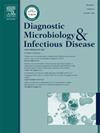哥伦比亚Turbo地区氯喹-伯氨喹治疗后间日疟原虫CYP2D6基因多态性及其与间日疟原虫复发的关系
IF 1.8
4区 医学
Q3 INFECTIOUS DISEASES
Diagnostic microbiology and infectious disease
Pub Date : 2025-07-16
DOI:10.1016/j.diagmicrobio.2025.117013
引用次数: 0
摘要
背景间日疟原虫由催眠子引起的复发是寄生虫在种群中持续存在的重要机制。伯氨喹(PQ)是消除催眠子的首选药物,需要细胞色素P450-2D6 (CYP2D6)的代谢激活。CYP2D6的遗传变异可以改变PQ代谢,潜在地增加复发的风险。本研究旨在检测间日疟原虫患者在氯喹-伯氨喹治疗下CYP2D6多态性,并探讨其与复发和PQ血浆水平的关系。方法对78例患者中的71例进行了scyp2d6表型和基因型测定。分析了9个多态性(snp和indel)和基因拷贝数变异。探讨CYP2D6表型、间日疟原虫6个月随访复发和PQ血浆水平之间的关系。结果大多数二倍型(81.7%)与正常(gNM-F)和超快速(gUM) CYP2D6代谢相关,18.3%与不良(gPM)和中间(gIM和gNM-S)代谢相关。与正常代谢组(正常/超快速)相比,CYP2D6活性受损组(差/中等)第2天的中位血浆PQ浓度更高(660.4 ng/ml vs 313.5 ng/ml;效应量r -0.51, 95% CI -0.82 ~ 0.03)。CYP2D6活性受损与正常患者复发的危险比(HR)无显著差异(调整后HR: 1.45;95% ci: 0.39-5.39)。结论哥伦比亚某流行区间日疟原虫感染个体CYP2D6活性表型受损较为常见。进一步的研究对于阐明这些表型与间日疟原虫复发之间的关系至关重要,正如本探索性研究所建议的那样。本文章由计算机程序翻译,如有差异,请以英文原文为准。

Polymorphisms of the CYP2D6 gene and its relationship with Plasmodium vivax relapses after chloroquine-primaquine treatment in Turbo, Colombia
Background
Plasmodium vivax relapse due to hypnozoites represents a significant mechanism for parasite persistence in the population. Primaquine (PQ), the drug of choice for eliminating hypnozoites, requires metabolic activation by Cytochrome P450-2D6 (CYP2D6). Genetic variations in CYP2D6 can alter PQ metabolism, potentially increasing the risk of relapses. This study aimed to determine CYP2D6 polymorphisms in subjects with Plasmodium vivax under supervised chloroquine-primaquine treatment and explore their association with relapses and PQ plasma levels.
Methods
CYP2D6 phenotypes and genotypes were successfully determined for 71 out of 78 patients included in the study. Nine polymorphisms (SNPs and indels) and gene copy number variation were analyzed. The association between the CYP2D6 phenotype, P. vivax relapse over six months follow-up, and PQ plasma levels were explored.
Results
Most diplotypes (81.7 %) were associated with normal (gNM-F) and ultrarapid (gUM) CYP2D6 metabolizers, while 18.3 % were associated with poor (gPM) and intermediate (gIM and gNM-S) metabolizers. The median plasma PQ concentration on day 2 was higher in impaired CYP2D6 activity group (poor/intermediate) compared normal metabolizers (normal/ultrarapid) (660.4 ng/ml vs 313.5 ng/ml; effect size r -0.51, 95 % CI -0.82 to 0.03). No significant difference was found in the hazard ratio (HR) of relapse between impaired and normal CYP2D6 activity (adjusted HR: 1.45; 95 % CI: 0.39–5.39).
Conclusion
Impaired CYP2D6 activity phenotypes were frequent in individuals infected with P. vivax from an endemic region of Colombia. Further research is essential to elucidate the relationship between these phenotypes and P. vivax relapses, as suggested by this exploratory study.
求助全文
通过发布文献求助,成功后即可免费获取论文全文。
去求助
来源期刊
CiteScore
5.30
自引率
3.40%
发文量
149
审稿时长
56 days
期刊介绍:
Diagnostic Microbiology and Infectious Disease keeps you informed of the latest developments in clinical microbiology and the diagnosis and treatment of infectious diseases. Packed with rigorously peer-reviewed articles and studies in bacteriology, immunology, immunoserology, infectious diseases, mycology, parasitology, and virology, the journal examines new procedures, unusual cases, controversial issues, and important new literature. Diagnostic Microbiology and Infectious Disease distinguished independent editorial board, consisting of experts from many medical specialties, ensures you extensive and authoritative coverage.

 求助内容:
求助内容: 应助结果提醒方式:
应助结果提醒方式:


